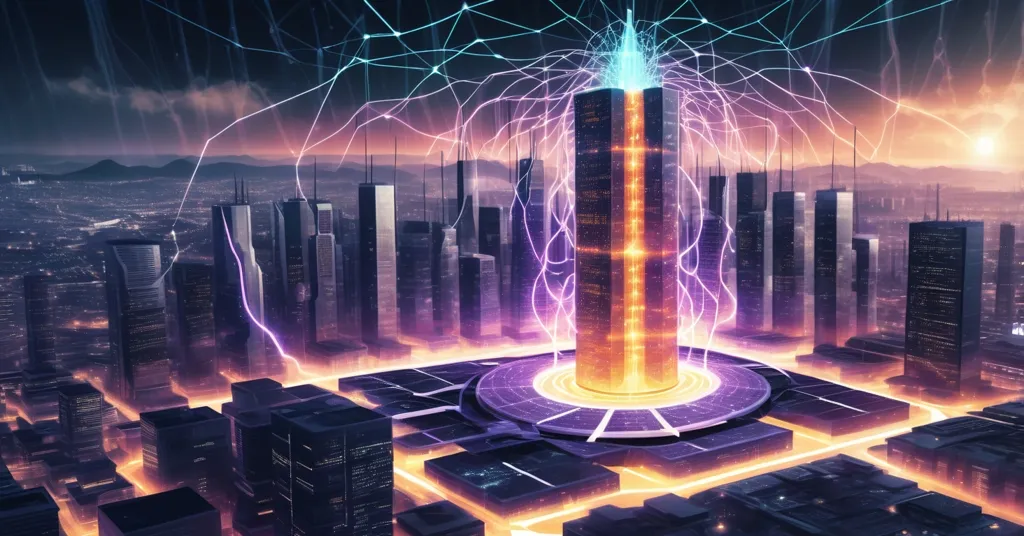OpenAI’s AI Power Surge: Energy Crisis Rivals Bitcoin Mining Debacle

OpenAI’s AI Ambitions: A Power Play That Could Rival Bitcoin Mining’s Energy Wars
OpenAI, the mastermind behind ChatGPT, has unleashed a series of blockbuster partnerships that could cement its dominance in artificial intelligence. With deals worth hundreds of billions, CEO Sam Altman is steering the company toward a future as a cloud computing juggernaut. Yet, the energy demands of this vision—rivaling even the most notorious Bitcoin mining farms—raise serious questions about feasibility, sustainability, and the broader implications for tech’s trajectory. Let’s dig into whether this is a genius move or a catastrophic misstep.
- Blockbuster Deals: Partnerships with Nvidia ($100B for GPUs), Oracle and SoftBank ($400B Stargate project), and Databricks for corporate expansion.
- Energy Abyss: Plans require 17 gigawatts of power, enough for 13 million homes or 17 nuclear plants.
- Crypto Echoes: AI’s hunger mirrors Bitcoin mining’s energy debates, with similar risks of backlash.
The Deals: OpenAI’s Bid to Rule AI Infrastructure
OpenAI’s latest moves are a clear signal: they’re not just playing in the AI sandbox; they’re aiming to own the entire playground. The partnership with Nvidia, valued at up to $100 billion, will equip OpenAI’s data centers with millions of GPUs—specialized chips that act like the turbocharged brains behind AI training, crunching massive datasets at lightning speed. Meanwhile, the Stargate project, a $400 billion endeavor with Oracle and SoftBank, is poised to create mega-facilities for running AI models at a scale previously unimaginable, starting with a site in Abilene, Texas. This isn’t just a data center; it’s a fortress designed to power the next leap in machine learning. Add to that a strategic alliance with Databricks to target corporate clients—think businesses integrating AI into everyday operations—and you’ve got a blueprint for both technological and market dominance.
Sam Altman, the man driving this juggernaut, sees it as more than a business play.
“Unlike previous technological revolutions or previous versions of the internet, there’s so much infrastructure that’s required, and this is a small sample of it,”
he stated, underscoring the physical backbone needed for AI’s ascent. These partnerships aren’t just about tech; they’re about building the very foundation of a future where AI could redefine everything from work to decision-making. For crypto enthusiasts, it’s reminiscent of Bitcoin’s early days—bold, disruptive, and hell-bent on reshaping the status quo, damn the consequences. In fact, recent developments show that OpenAI is navigating significant challenges following these massive AI deals, highlighting the complexity of their ambitions.
The Energy Quagmire: A Grid-Shattering Challenge
Here’s where the dream hits a brick wall: power. OpenAI’s infrastructure ambitions demand a staggering 17 gigawatts of capacity—enough to light up over 13 million American homes or roughly the output of 17 nuclear power plants. To put that in perspective, imagine a mid-sized city like Austin, Texas, running entirely on the juice needed just for OpenAI’s servers. Altman is keenly aware of this hurdle and isn’t shy about his solution.
“I am extremely bullish about nuclear, advanced fission, fusion. We should build more … a lot more of the current generation of fission plants, given the needs for dense, dense energy,”
he declared. He’s betting on nuclear as the dense energy source to fuel this revolution, alongside experimental tech like fusion that’s still years, if not decades, from practicality.
But let’s cut the optimism with some harsh reality. Building a nuclear plant isn’t like slapping together a prefab shed—it takes at least a decade, often more, assuming you can navigate regulatory mazes and public opposition. Gas turbines, a faster stopgap, are sold out until 2028 due to global demand. The U.S. power grid? Already wheezing under existing strain, with blackouts a growing risk in states like California during peak usage. Renewables like solar and wind sound nice, but inconsistent output and political gridlock—especially with shifting federal policies—make them unreliable for this kind of relentless, 24/7 need. It’s a damn mess, and OpenAI’s timeline might as well be written in fairy dust. If Bitcoin miners got dragged for grid-gobbling, OpenAI’s neon sign might as well read, “Regulators, come get me!”
Bitcoin’s Ghost: Energy Debates Haunt AI’s Rise
For those of us steeped in the crypto world, this energy crisis feels like déjà vu. Bitcoin mining has long been slammed for its power consumption, with global estimates pegging its draw at around 15 gigawatts annually in recent years—close to OpenAI’s target, but spread across a decentralized network rather than a single entity’s plan. China’s 2021 crackdown on mining, citing environmental strain, forced operations to scatter to places like Kazakhstan and Texas, often sparking local grid issues. The backlash was fierce, with environmentalists and policymakers painting miners as reckless energy hogs. AI could be next, especially if data centers start blacking out small towns—a scenario not unlike mining farms overloading rural grids in upstate New York.
Yet, crypto offers lessons OpenAI might heed. Ethereum’s shift to Proof of Stake in 2022 slashed its energy use by nearly 99%, proving tech can pivot from brute force to efficiency when push comes to shove. Could AI explore analogous models, like distributed computing or edge processing, to lighten the load? Or will it bulldoze ahead like early Bitcoin, consequences be damned? Industry voices see the stakes clearly. Deedy Das of Menlo Ventures backs Altman’s audacity:
“I don’t see this as crazy. I see it as existential for the race to superintelligence,”
he said, adding,
“One of his gifts is reading the exponential and planning for it.”
But exponential growth cuts both ways—compute power might soar, yet so might public and regulatory ire if the grid can’t keep up.
Centralization Clash: OpenAI vs. Crypto’s Core Ethos
Let’s zoom out and confront a deeper tension. OpenAI’s model—centralized cloud computing on a massive scale—sits uncomfortably with the decentralized ethos that defines Bitcoin and much of the crypto space. We’ve spent over a decade fighting gatekeepers, from banks to Big Tech, championing systems where power (and data) is distributed, not hoarded. If Altman’s vision succeeds, OpenAI could become the ultimate gatekeeper of AI, controlling infrastructure that shapes future economies and societies. Imagine a world where one company holds the keys to superintelligence—doesn’t that smell like the monopolistic stench we’ve rallied against?
Beyond control, there’s privacy. Centralized AI data hubs are treasure troves for hackers, governments, or corporate overreach, much like centralized crypto exchanges have been juicy targets (think Mt. Gox or FTX). Could this spark a counter-movement in the blockchain world—decentralized AI protocols running on networks like Ethereum, where no single entity calls the shots? The disruptive spirit aligns, even if the tech doesn’t yet. OpenAI’s push might just ignite the next frontier for crypto innovation, flipping a potential overlord into a catalyst for freedom-focused tech.
The $125 Billion Bet: Brilliance or Bust?
OpenAI’s internal forecasts project a whopping $125 billion in revenue by 2029, a number that screams confidence—or delusion. On the upside, if they pull off this infrastructure feat, they’ll meet skyrocketing demand for AI services, from corporate tools to consumer apps, raking in cash as the backbone of a new digital era. Think Bitcoin’s price surge during adoption booms, but for compute power instead of coins. Yet, the upfront costs are astronomical, and the energy bottlenecks could turn this into a black hole of investment. Competitors like Google or Anthropic, with leaner strategies or existing infrastructure, might outmaneuver OpenAI while it’s busy begging for grid access. It’s a high-roller’s gamble—win big or crash hard.
AI and Blockchain: Collision or Collaboration?
Looking ahead, the intersection of AI and blockchain could be where the real fireworks happen. Could OpenAI’s data centers leverage blockchain for secure, transparent data sharing, much like smart contracts secure transactions on Ethereum? Might Bitcoin miners, facing their own energy scrutiny, pivot to AI computing for profit, blending two power-hungry beasts into a symbiotic beast? Or could the crypto community, smelling centralization a mile away, accelerate decentralized AI alternatives—think open-source models running on distributed networks, free from corporate clutches? The stakes are as high as they were when Bitcoin first challenged fiat. OpenAI’s empire-building might just force us to rethink not just power, but power structures, in tech’s next chapter.
Key Takeaways and Burning Questions
- What are the major partnerships fueling OpenAI’s AI dominance?
OpenAI has locked in transformative deals with Nvidia for $100 billion in GPU-powered data centers, Oracle and SoftBank for the $400 billion Stargate mega-project, and Databricks to capture corporate markets, all aimed at unparalleled AI infrastructure. - Why is energy OpenAI’s biggest roadblock?
Their need for 17 gigawatts—enough for 13 million homes—demands infrastructure like 17 nuclear plants, which take over a decade to build, while grid strain, sold-out gas turbines, and renewable politics complicate the picture. - How does AI’s energy crisis parallel Bitcoin mining’s struggles?
Just as Bitcoin mining’s massive power draw led to bans and backlash, like China’s 2021 crackdown, AI’s similar appetite could trigger regulatory storms and public outcry if grids buckle. - Is OpenAI’s $125 billion revenue goal by 2029 achievable?
It’s a bold target that could materialize if infrastructure hurdles clear, but the upfront costs and logistical chaos make it a risky bet—success isn’t guaranteed. - Does OpenAI’s centralized model clash with crypto’s decentralized ideals?
Absolutely—OpenAI’s cloud computing empire risks creating a tech overlord, contradicting Bitcoin’s distributed ethos, though its disruption of old systems shares a rebellious streak. - Could blockchain tech address AI’s centralization and privacy risks?
Potentially—decentralized AI protocols on networks like Ethereum could counter OpenAI’s gatekeeper model, ensuring data and power aren’t hoarded by one entity. - What future synergies might emerge between AI and crypto?
Blockchain could secure AI data sharing, miners might pivot to AI computing, and crypto’s push for decentralization could inspire open-source AI alternatives, blending disruption with innovation.



